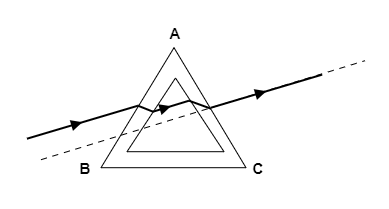
A ray of light is incident on a hollow glass prism as shown. Then the ray of light will undergo:

A) Both deviation and dispersion.
B) Deviation but not dispersion.
C) Dispersion but not deviation.
D) Neither deviation nor dispersion.

Answer
563.7k+ views
Hint:Dispersion refers to the splitting of white light into its component colours as it passes through a glass prism. Deviation refers to the difference in the angle of the emerging ray from the angle at which the light was incident on the glass prism. Here the light ray will undergo refraction as it enters and leaves the sides of the hollow glass prism.
Complete step by step answer.
Step 1: Sketch a figure describing how the ray of incident light emerges out of the hollow glass prism.
The hollow glass prism can be considered to be made of three glass slabs which are arranged to form an isosceles triangle ABC. This is shown in the figure below.

So when a ray of light is incident on the side AB, it will undergo refraction and bend towards the normal as it enters the side AB. As it leaves the side AB, it will bend away from the normal and will be incident on the side AC at the same angle at which the light was incident on AB. Just as in AB, the light ray will undergo refraction while entering and exiting the side AC. The ray emerging out of AC will be parallel to the incident ray and so the angle of deviation will be zero. This is shown in the figure given below.

Thus the light ray does not undergo dispersion or deviation.
So the correct option is D.
Note:Deviation only happens when the surface into which the light enters and the surface out of which the light exits are not parallel to each other. Refraction of a light ray does not ensure the deviation of the light ray. Light entering a denser medium will bend towards the normal and light leaving the denser medium to enter a rarer medium will bend away from the normal. Here when the light ray enters sides AB and AC it enters the denser medium of glass and as light leaves these sides it enters the rarer medium of air.
Complete step by step answer.
Step 1: Sketch a figure describing how the ray of incident light emerges out of the hollow glass prism.
The hollow glass prism can be considered to be made of three glass slabs which are arranged to form an isosceles triangle ABC. This is shown in the figure below.

So when a ray of light is incident on the side AB, it will undergo refraction and bend towards the normal as it enters the side AB. As it leaves the side AB, it will bend away from the normal and will be incident on the side AC at the same angle at which the light was incident on AB. Just as in AB, the light ray will undergo refraction while entering and exiting the side AC. The ray emerging out of AC will be parallel to the incident ray and so the angle of deviation will be zero. This is shown in the figure given below.

Thus the light ray does not undergo dispersion or deviation.
So the correct option is D.
Note:Deviation only happens when the surface into which the light enters and the surface out of which the light exits are not parallel to each other. Refraction of a light ray does not ensure the deviation of the light ray. Light entering a denser medium will bend towards the normal and light leaving the denser medium to enter a rarer medium will bend away from the normal. Here when the light ray enters sides AB and AC it enters the denser medium of glass and as light leaves these sides it enters the rarer medium of air.
Recently Updated Pages
A man running at a speed 5 ms is viewed in the side class 12 physics CBSE

State and explain Hardy Weinbergs Principle class 12 biology CBSE

Which of the following statements is wrong a Amnion class 12 biology CBSE

Two Planoconcave lenses 1 and 2 of glass of refractive class 12 physics CBSE

The compound 2 methyl 2 butene on reaction with NaIO4 class 12 chemistry CBSE

Bacterial cell wall is made up of A Cellulose B Hemicellulose class 12 biology CBSE

Trending doubts
What are the major means of transport Explain each class 12 social science CBSE

Which are the Top 10 Largest Countries of the World?

Explain sex determination in humans with line diag class 12 biology CBSE

Draw a labelled sketch of the human eye class 12 physics CBSE

How much time does it take to bleed after eating p class 12 biology CBSE

Suicide bags of cells are aEndoplasmic reticulum bLysosome class 12 biology CBSE




